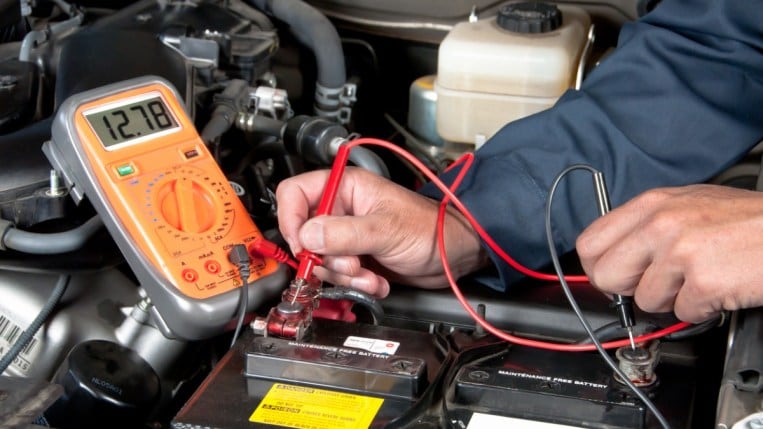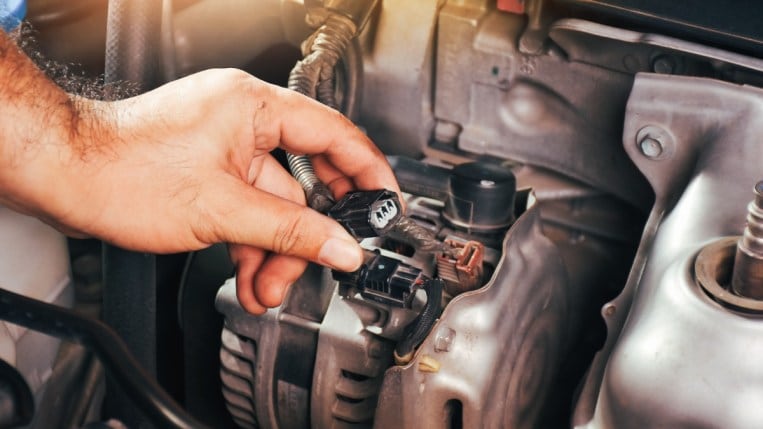Quick Facts About Cars Not Starting
- Get your car battery regularly tested so it doesn’t fail on you.
- One of the most common reasons for a car not starting is having no gas.
- Electric cars can also have trouble starting, often caused by a bad battery.
There are many reasons why your car isn’t starting, from a bad battery to a failed fuel pump. A vehicle failing to start could be anything from a simple problem to a more complex one.
Keep reading to learn the reasons why your car isn’t starting, what noises to listen for, and what you can do to keep your vehicle in running order.
Reasons Your Car Won’t Start
When your car doesn’t start, sometimes it can be as simple as needing a new battery in a dead key fob. Based on Kelley Blue Book certified mechanic Gary Hardesty’s research and experience, we will list the top reasons why your vehicle won’t start.
Some issues you can quickly fix. For others, you must take your vehicle to a dealership or an auto repair shop.
Out of Fuel
Hardesty says one of the most common reasons a car won’t start is that it’s out of gas, which is also the easiest issue to fix. If your vehicle won’t turn on because it lacks fuel, you’ll need to get some in a gasoline-safe container. You can also call a family member, friend, AAA, or another towing service to acquire gas for you.
Your car can also stop working mid-drive if you run out of fuel. Remember to refuel before the vehicle reaches a quarter of the tank to avoid getting too low until you find a gas station.
Battery Problems


Bad Battery
A dead battery is a common reason your car won’t start, right next to having no fuel. Knowing when the battery has gone bad is easy to diagnose. When the car cranks up slowly and makes a clicking sound, it’s a telltale sign that the 12-volt battery up front is not healthy.
If your battery has completely died, you can try to jump-start the vehicle to get back on the road, giving you enough time to get to a car parts store or dealership to replace the battery. You can also try to replace the battery if you’re handy or have it installed by a professional.
You can regularly test your battery’s health at a local car parts store, where it can be done — often for free.
Dead Electric Car Battery
A dead electric vehicle (EV) drive battery is never good. However, it happens. In this situation, you’ll likely need to plug in the electric vehicle (EV) or get your vehicle towed to the nearest charging station.
But be careful; letting your drive battery die too frequently can damage the battery’s health and lead to premature battery wear and tear and costly repairs.
Fuel Pump Issue
Your fuel pump works with your car’s gas engine to initiate the combustion that starts the car. Like a bad battery, you can tell when it’s going bad if the car takes a while to crank up. Other signs include the check engine light coming on or trouble accelerating the vehicle.
A car’s engine consists of myriad components. If the check engine light comes on solid or you experience any of the stated issues, make sure to get your vehicle inspected to ensure it’s safe to drive. If the check engine light starts to flash, the problem becomes much more immediate and a time to pull over and get help.
MORE: Car Suspension: 6 Signs Something Is Off
Starter Failed
The starter is a mechanism that aids in the engine’s internal combustion, essentially making the car start. If the starter fails, the car won’t start — that’s why it’s called the starter. Luckily, you’ll notice some symptoms before it completely fails.
The most common ones include a low engine crank and electrical problems.
The starter carries electricity, so the starter is likely to blame if you notice lights coming on when cranking the car. You’ll need to fix this issue at a dealership or auto repair shop.
Bad Alternator


Your alternator sends electricity to many components of your car, from the lights to the infotainment system. It also recharges your battery once the vehicle has started, so it can affect the battery once it goes bad. Since it controls most of the electrical systems in a vehicle, you’ll get some signs. For example, if you notice your lights aren’t as bright or the audio output isn’t as high, something could be wrong with the alternator.
If you start seeing these signs, get your car checked. When an alternator goes bad, it means your battery could be next.
Stuck Steering Wheel
If you get into your car and can’t even turn the key in the ignition to start it, your steering wheel has locked as an anti-theft protective measure. This issue is less common, especially with the rise in digital keys. Luckily, there’s a straightforward fix.
Insert the key into the ignition and turn it slightly. Then, turn the steering wheel left and right. After this action, the wheel should unlock, and you can start your car.
MORE: Car Shocks and Struts: Signs They Are Worn Out
What to Do if Your Car Won’t Start
There are several common culprits to consider when your car won’t start. If you’re unable to diagnose or resolve the issue yourself, it’s best to seek professional help from an auto club, roadside assistance service, or a mechanic at a service center. A dead or faulty battery is often the primary cause, identifiable by slow cranking or clicking sounds. Fuel-related issues, such as an empty tank or a malfunctioning fuel pump, can also prevent your car from starting. Other potential problems include a failed starter motor, a bad alternator, or a stuck steering wheel. In some cases, it could be a dead key fob battery or the car not being in the correct gear.
Regular maintenance is crucial to keep your vehicle’s reliability and retain its value. To help ensure starting when you’re ready to go, monitor the fuel level, keep the battery in good condition, and observe warning signs. Address issues and have repairs made promptly.
Editor’s Note: This article has been updated since its original publication.

